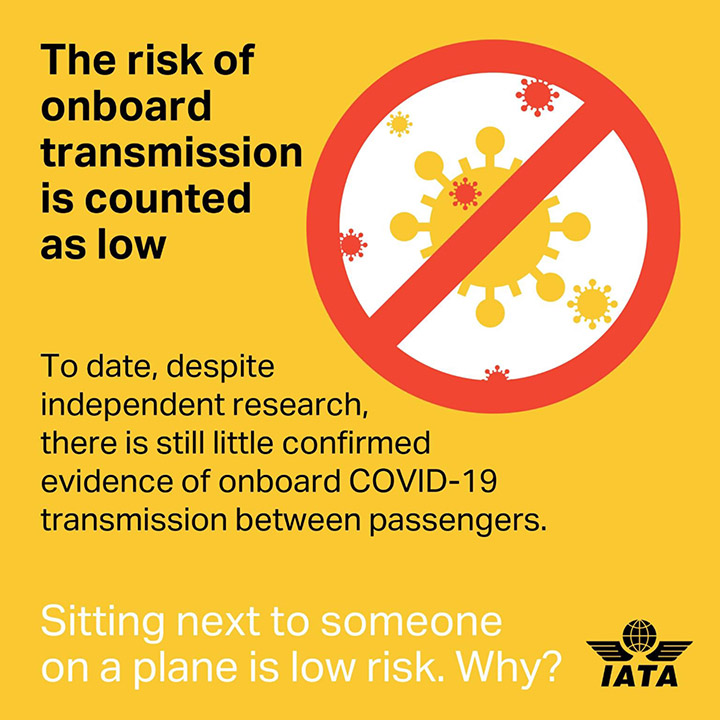Safely Restarting Aviation During COVID-19
This site uses cookies. By continuing to browse the site you are agreeing to our use of cookies. Read our privacy policy>
![]()
Enterprise products, solutions & services

The aviation industry started 2020 with optimism: We expected to transport 4.7 billion passengers last year, but the COVID-19 pandemic has had a devastating impact. Passenger demand has evaporated — partly because people are afraid to travel, and partly because many borders are closed. And even when and where borders are open, governments are imposing quarantine periods.
As a result, we're facing a US$118.5 billion net loss for 2020. Losses of US$38.7 billion are forecast for 2021. And we aren't expecting passenger demand to return to 2019 levels until 2024 — a year later than previously anticipated.
This is the biggest crisis in the history of the airline industry. We saw passenger demand hit rock bottom in April 2020, and demand was about 80% below 2019 levels by July. Clearly, the industry has a lot of work to do to recover.
The first priority is to ensure passengers can fly safely. IATA, national governments, the World Health Organization (WHO), and many industry partners have contributed to the International Civil Aviation Organization's (ICAO) take-off guidance to restart aviation.
The key elements of the guidance include: mask-wearing during travel, more frequent and more thorough sanitization of aircraft, contactless processes, simplified cabin services, automated procedures for customs and border protection, limited access and temperature screening at airport terminals, health declarations, and social distancing where possible.

These pragmatic guidelines will reduce the risk of transmission when traveling. They were developed in record time, too — under the leadership of ICAO and with the full support of the industry. Now, they must be implemented. Because aviation is a network business, the implementation of these measures must be universal and respect local guidance. Many governments are trying to restart their economies, and they must act fast.

There is also an urgent need to rebuild passenger confidence, and this will be a significant challenge. At the beginning of March, approximately 60% of travelers said they would return to travel within a few months of the pandemic coming under control. By early June, that figure had dropped to 45%.
Communicating the measures that we have taken to keep travelers safe is key to addressing these concerns. At IATA, that's exactly what we're doing. And we're also working across the industry to send an aligned message — this includes addressing concerns about contracting COVID-19 on a flight.
In fact, there are very few cases of onboard transmission. That's partly because there are several cabin factors that naturally limit the spread of droplets: Everyone is facing forward, the seat backs are a barrier, people generally don't move around very much, and air circulates from top to bottom — not back to front.
On top of that, the quality of air onboard is much better than most indoor environments. High-Efficiency Particulate Air (HEPA) filters in modern aircraft ensure that recirculated air is similar to what you would find in a hospital operating theater. And the air is exchanged for fresh air from outside 20 to 30 times an hour — about ten times more frequently than most office buildings. Add to that all the biosafety measures in place, following the ICAO's take-off guidance — such as mask wearing — and we have an impressive story to tell about the low risk of transmission on commercial flights.
Key to the recovery of the industry is the opening of borders, of course, and the lifting of travel restrictions and measures such as quarantining. Unfortunately, air travel remains largely closed around the world, despite the availability of global protocols to enable the safe restart of aviation.
The prerequisite to opening borders is the ICAO's take-off guidance. Additionally, IATA is proposing 'travel bubbles' — exclusive partnerships between countries that have demonstrable success in containing COVID-19 — to mitigate risks between specific markets, and foresees a much wider and strategic use of COVID-19 testing as technology improves accuracy, speed, and scalability.
IATA has also proposed a three-point action plan for governments to safely re-open borders:
1. Implement the ICAO take-off guidance universally.
2. Build on the solid work of ICAO Council's Aviation Recovery Task Force (CART) by developing an agreed common framework for states to use in coordinating the safe re-opening of their borders to aviation.
3. Develop COVID-19 testing measures that will enable the re-opening of borders by reducing the risk of COVID-19 importation to a level acceptable to public health authorities, with the accuracy, speed, and scalability that meet the exacting requirements for incorporation into the travel process.
There is no single measure that can mitigate all the biosafety risks of restarting air travel. However, we believe that implementation of the measures we have outlined, which are already feasible, is the most effective way of balancing risk mitigation with the need to unlock economies and enable travel in the immediate term.
The following activities are good examples where technology has a critical role to accelerate these adaptations.
With concerns about limiting face-to-face interaction and the need to reduce the touching of common surfaces, contactless travel applications will be key. Based on self-sovereign identity and decentralized trust, these applications aim to securely share biometrics and travel data while reducing the number of physical touch points during the journey.
There are many touchpoints across the passenger journey. All these interactions across the different stakeholders in the industry naturally present great opportunities for data collection, but have also been disrupted because of the pandemic.
To support the successful restart of the industry, innovative ways of factoring in all aspects of the 'new normal' are required: for example, advanced data analytics solutions, based on machine learning algorithms, could be used to provide leading indicators for capacity planning and industry dashboards.
Collecting and processing passenger data for health-related matters is becoming increasingly critical for the restart of the air industry and for restoring passengers' trust. This is why a multi-layered cybersecurity program is needed to respond to the cyber security challenge of remaining safe, secure, sustainable, and resilient to cyber security risks, while enabling state-of-the-art digitalization and connectivity in the industry. These initiatives will enable the industry to increase its profitability, boost efficiency, and improve the customer experience, in compliance with data privacy regulations, helping the aviation industry to rise out of this difficult period and gain new momentum.
International Air Transport Association is an international trade association for the world's airlines. The organization represents some 290 airlines, comprising 82% of global air traffic.

Huawei is a key strategic partner of IATA — helping us to deliver cross-industry solutions that are interoperable, consistent, secure, scalable, affordable, and simple to implement and operate.
— Pascal Buchner, Director of Information Technology Services and CIO, International Air Transport Association (IATA)